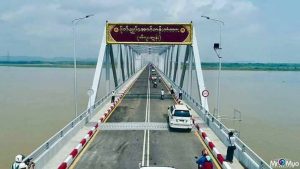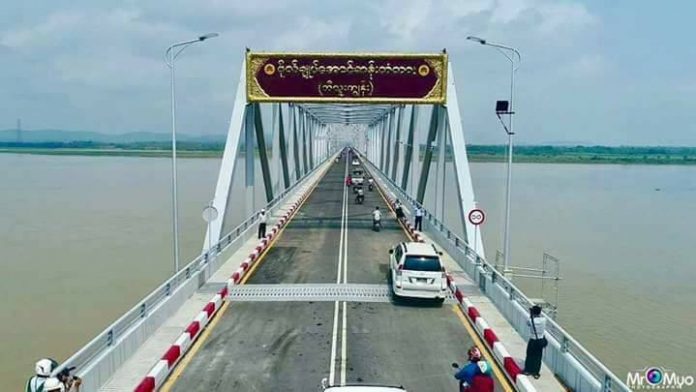Under the cover of early morning darkness on April 27, authorities in Mon State affixed signs bearing the name General Aung San to the bridge and opened it to traffic, ending one chapter in a simmering dispute over ethnic rights in Myanmar (Burma). But even as authorities tried to put the controversy behind them, opponents promised to continue their fight.

The only warning for the opening came in a 9:30pm Facebook post on the night of April 26 from the Mon State Chief Minister Dr. Aye Zan, who wrote, “the public will be able to cross the General Aung San Bridge (Bilugyun) tomorrow from 5am to 10pm. May Mon State develop and the public find peace of mind.”
Protests against the bridge have been spearheaded by a group called the Committee of Public Movement for Thanlwin Bridge, which has vowed to continue its campaign despite the opening of the bridge.
“We are planning to meet to discuss how to continue our work. We have already sent an open letter to the international community and continue to collect petition signatures urging the government to honor the original name of the bridge, the Thanlwin Bridge (Chaungzon),” said Min Aung Mon, a member of the committee.
The committee began collecting signatures on April 13 and by April 25 had over 120,000. Most are from Mon State, though the issue has resonated with other minority ethnic groups and activists, especially in Kayin (Karen) State and Bago and Yangon (Rangoon) regions. The group plans to submit the petition to the Union Government in Naypyitaw.
Protest have swirled since the ruling National League for Democracy (NLD), which holds a majority of seats in the Mon State Parliament and in the Mon delegation to the Union Parliament, voted in March to name the Bridge for General Aung San, Myanmar’s independence leader. Many in Mon State believe the name should reflect Mon history, rather than General Aung San, who hailed from the majority Burman ethnic group.
On March 19 more than 20,000 people joined a protest in the Mon State capital Mawlamyine (Moulmein) lead by the Committee of Public Movement for Thanlwin Bridge (Chaungzon). In Early April, 14 political parties issued a statement opposing the name, arguing that it hurt national solidarity and efforts to reconcile a country that has known decades of conflict.

